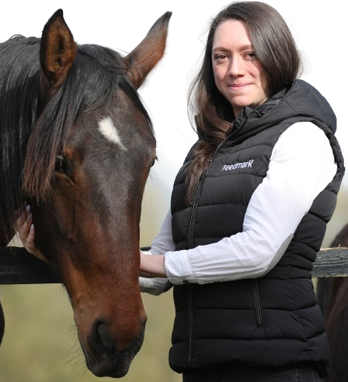COLIC - You can start the day as normal with your lovely horse and by the end of the day, despite best veterinary care and your efforts, suddenly your horse is gone. 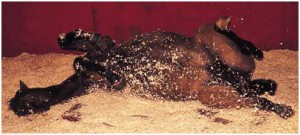 Colic simply means abdominal pain and this can vary in case from simple indigestion to life threatening twisted gut. Horses react to a “painful belly” in different ways, some will become quiet and shut down, whilst others will be more dramatic, getting up and down, rolling, striking out, kicking at their belly. Profuse sweating and a disregard for people and no sense of self preservation (ie they will chuck themselves on the concrete or bang their heads as they crash against the stable wall) are usually signs of severe pain and in particular a colonic torsion (twisted gut). Signs of colic
Colic simply means abdominal pain and this can vary in case from simple indigestion to life threatening twisted gut. Horses react to a “painful belly” in different ways, some will become quiet and shut down, whilst others will be more dramatic, getting up and down, rolling, striking out, kicking at their belly. Profuse sweating and a disregard for people and no sense of self preservation (ie they will chuck themselves on the concrete or bang their heads as they crash against the stable wall) are usually signs of severe pain and in particular a colonic torsion (twisted gut). Signs of colic
- Not eating
- Rolling
- No droppings
- Sweating
- Dog sitting
- Frequently getting up and down / unsettled
- Pawing the ground
- Kicking at belly
- Looking round at belly
- Depression
- Self-trauma
There are many causes of colic, but this article is going to explain why sand is an important consideration when dealing with a case of colic. 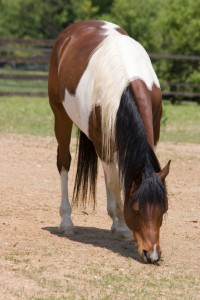 How does sand get into the gut? Horses eat it. Some horses will eat dirt – perhaps because they are salt deficient. On poor grazing, horses may pull up roots and ingest sand with the grass or when turned out in a sand school they may ingest the sand with the hay or through boredom. There is definitely an individual variation related to each horse’s grazing pattern because not all horses on the same paddock will accumulate sand in the gut. We often see an increase in the number of sand colics following a certain weather pattern – after a period of dryness, heavy rain will cause the sand from the soil to splash up onto the grassy leaf and therefore it is impossible to eat the grass without the sand. Why is the sand a problem in the gut? Sand is quite rough and can irritate the gut wall as it is dragged along, but most of the problems we see are caused by an accumulation (collecting together) of the sand within the gut. The horse’s gut is about 30 metres long from mouth to anus (bottom). Its’ design involves at least 3 hairpin bends and other dramatic changes in diameter – some parts of the gut are only 4cm in diameter (width of tube that food passes through) whilst other parts have a diameter of at least 10cm. These design faults of sudden changes in size and angle of gut make the horse more susceptible to colic.
How does sand get into the gut? Horses eat it. Some horses will eat dirt – perhaps because they are salt deficient. On poor grazing, horses may pull up roots and ingest sand with the grass or when turned out in a sand school they may ingest the sand with the hay or through boredom. There is definitely an individual variation related to each horse’s grazing pattern because not all horses on the same paddock will accumulate sand in the gut. We often see an increase in the number of sand colics following a certain weather pattern – after a period of dryness, heavy rain will cause the sand from the soil to splash up onto the grassy leaf and therefore it is impossible to eat the grass without the sand. Why is the sand a problem in the gut? Sand is quite rough and can irritate the gut wall as it is dragged along, but most of the problems we see are caused by an accumulation (collecting together) of the sand within the gut. The horse’s gut is about 30 metres long from mouth to anus (bottom). Its’ design involves at least 3 hairpin bends and other dramatic changes in diameter – some parts of the gut are only 4cm in diameter (width of tube that food passes through) whilst other parts have a diameter of at least 10cm. These design faults of sudden changes in size and angle of gut make the horse more susceptible to colic. 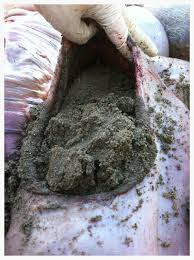 Sand impaction of the large bowel[/caption] Because sand is heavy it sinks as it passes along the gut and it starts to collect at the bottom of the gut forming a layer. This layer of sand stops that piece of gut moving correctly (peristalsis is the technical name for the way your gut pumps food along). Over time this layer gets deeper and quite a “weight” of sand can collect as the rest of the food/liquid just moves along over the top of it. The sand can also accumulate at the hairpin bends in the horse’s gut. The weight of the sand can affect the horse’s performance – imagine trying to be athletic with a sandbag strapped to your belly! The accumulation of sand and slowing of gut mobility can lead to an impaction (sand blockage). If you have ever tried to wash sand away (for example, clearing up after a beach outing) you’ll have noticed how persistent the sand is at hanging around and blocking the plug hole! This blocking effect is exactly what can happen in the horse’s gut too. Because sand can affect the gut in different ways horses suffering from sand accumulation can be ill in different ways. Here are some examples:-
Sand impaction of the large bowel[/caption] Because sand is heavy it sinks as it passes along the gut and it starts to collect at the bottom of the gut forming a layer. This layer of sand stops that piece of gut moving correctly (peristalsis is the technical name for the way your gut pumps food along). Over time this layer gets deeper and quite a “weight” of sand can collect as the rest of the food/liquid just moves along over the top of it. The sand can also accumulate at the hairpin bends in the horse’s gut. The weight of the sand can affect the horse’s performance – imagine trying to be athletic with a sandbag strapped to your belly! The accumulation of sand and slowing of gut mobility can lead to an impaction (sand blockage). If you have ever tried to wash sand away (for example, clearing up after a beach outing) you’ll have noticed how persistent the sand is at hanging around and blocking the plug hole! This blocking effect is exactly what can happen in the horse’s gut too. Because sand can affect the gut in different ways horses suffering from sand accumulation can be ill in different ways. Here are some examples:-
- Diarrhoea
- Normal dung with squirt of fluid at the end
- Intermittent low grade colic
- Heavy (in weight) heaps of dung
- No dung passed
- Bloated/pot belly
- Slow when ridden
- Depressed or just a bit quiet
- Grumpy
- Laying down
- No signs
- Straining to pass dung
- Any other ‘colic’ signs
How do you find out if your hose has any sand accumulation in the gut?
- Test the dung – anything more than ½ teaspoon of sand could be significant.
- Bucket of water – add generous double handful of dung and STIR.
- Leave 10 minutes and stir again.
- Wait one minute and tip out the water and dung and see how much sand is left in the bottom of the bucket (1/2 teaspoon requires action). This is known as a sand dung test.
- Test weekly.
So how can we remove this sand? Psyllium husks are part of the seed of the plant “plantago ovata” grown mainly in India and Pakistan. These husks are indigestible and are used as dietary fibre in man to help in the treatment of irritable bowel syndrome, constipation and diarrhoea. When psyllium is mixed with water these dry husks turn into a gel (very similar to wall paper paste!). As it passes through the horse’s gut this gloopy gel picks up particles e.g. sand as it passes through and steadily removes the sand via the dung. In severe impactions / sick horses vets will stomach tube large quantities of psyllium at least twice a day – Vets often use other products too in severe cases and, very importantly, provide pain relief. If you are worried about your horse or anything you have read please contact your veterinary surgeon. Psyllium can also be used regularly in a preventative fashion to prevent accumulation. The rate and regularity of using psyllium should be planned with your vet and structured according to your sand dung test results. Test all horses, not just one! Psyllium should be fed dry or on top of damp feed to avoid a slimy mush that your horse may refuse to eat.
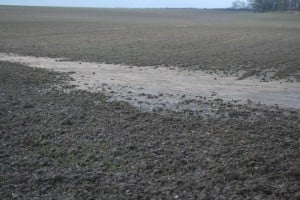 East Anglia has recognised sandy areas east of the A12 similar to Holland where sand colic is also a problem. Please note heavy clay soils also contain SAND – see photo of clay field after heavy rain showing lots of sand – Test your horse even if your soil seems heavy!
East Anglia has recognised sandy areas east of the A12 similar to Holland where sand colic is also a problem. Please note heavy clay soils also contain SAND – see photo of clay field after heavy rain showing lots of sand – Test your horse even if your soil seems heavy! 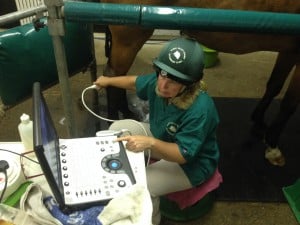 Please feel free to look on our website or contact me for further details. Helen Whitbread BVetMed CertVR MRCVS, Deben Valley Equine Vet Clinic, Birds Lane, Framsden, Suffolk IP14 6HR. (01728) 685 123. www.debenvalleyvet.co.uk
Please feel free to look on our website or contact me for further details. Helen Whitbread BVetMed CertVR MRCVS, Deben Valley Equine Vet Clinic, Birds Lane, Framsden, Suffolk IP14 6HR. (01728) 685 123. www.debenvalleyvet.co.uk
